Prashanth Dental Clinic(Vijayanagar)
Procare Dental Clinic(Nagarabhavi)
Talk to us
+91-080-23352628
+91-080-23214995
+91-080-23352628
+91-080-23214995

COSMETIC DENTAL TREATMENTS
Cosmetic dental treatments can improve the appearance of your teeth. Cosmetic treatments tend to look better and last longer if you have healthy teeth and gums. If you have tooth decay or gum disease, this should be treated before any cosmetic dentistry begins.
Composite Restorations
A composite filling is a tooth-colored plastic and glass mixture used to restore decayed teeth. Composites are also used for cosmetic improvements of the smile by changing the color of the teeth or reshaping disfigured teeth.
A composite tooth filling, typically made of powdered glass and acrylic resin, offers a few advantages over an amalgam filling. For one, the filling can be shaded to match the color of a person's existing teeth, making it much less visible.
A composite tooth filling, typically made of powdered glass and acrylic resin, offers a few advantages over an amalgam filling. For one, the filling can be shaded to match the color of a person's existing teeth, making it much less visible.
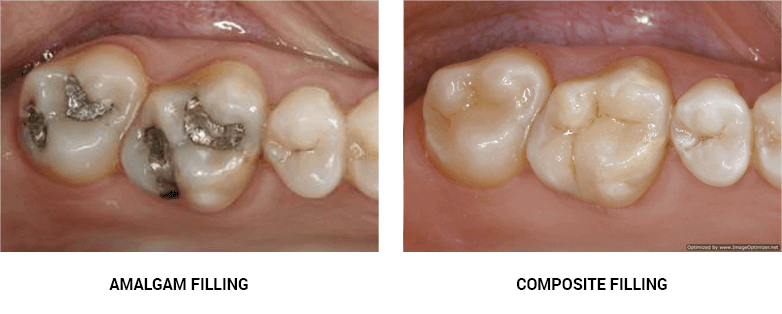
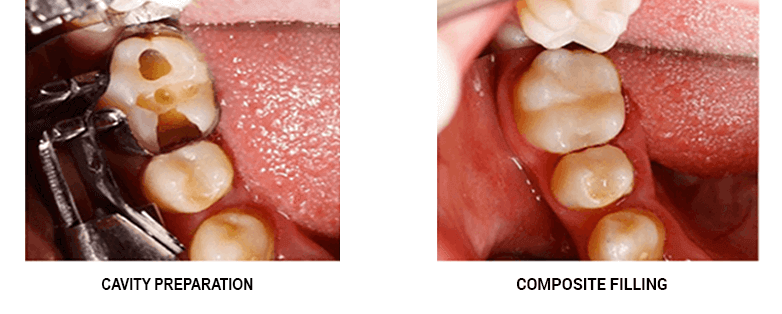
Advantages and disadvantages of composite fillings as compared to amalgam ones.
- Since dental amalgam is a metal, it's a good thermal conductor. And when it's used to make fillings (especially relatively large ones) it's not uncommon that a person will experience some degree of thermal sensitivity with their tooth when it's exposed to hot and cold foods and beverages.
since dental composite is a plastic and therefore a comparatively poor thermal conductor, when it is used for a filling this issue is much less of a concern. - Once placed, a dental amalgam filling requires several hours of hardening before it is ready to be put into service.
In comparison, a bonded filling is fully cured (set) during its placement process. That means once a person's procedure has been completed, the tooth and its new filling are ready for use. - If a defect is found in a dental composite restoration, it may be possible for the dentist to just make a repair rather than replace the whole thing. That's because the newly added composite is able to create a bond with both the tooth and its existing filling.
Composite Bonding
Composite bonding is a cosmetic technique wherein a type of dental material – in this case, composite resin – is shaped and molded on your teeth to give the appearance of straighter, whiter smile. It can be used as a cosmetic solution to chipped teeth, gapped teeth and staining in both teeth and fillings.
The procedure gets its name because materials are bonded to the tooth. Bonding is typically used for cosmetic purposes to improve the appearance of a discolored or chipped tooth.
The procedure gets its name because materials are bonded to the tooth. Bonding is typically used for cosmetic purposes to improve the appearance of a discolored or chipped tooth.
Dental bonding can be considered to fix the following dental issues:
Disadvantages of dental bonding include:
- To repair decayed teeth (composite resins are used to fill cavities)
- To repair chipped or cracked teeth
- To improve the appearance of discolored teeth
- To close spaces between teeth
- To make teeth look longer
- To change the shape of teeth
- As a cosmetic alternative to amalgam fillings
- To protect a portion of the tooth's root that has been exposed when gums recede
Composite Bonding to Close Space between Teeth
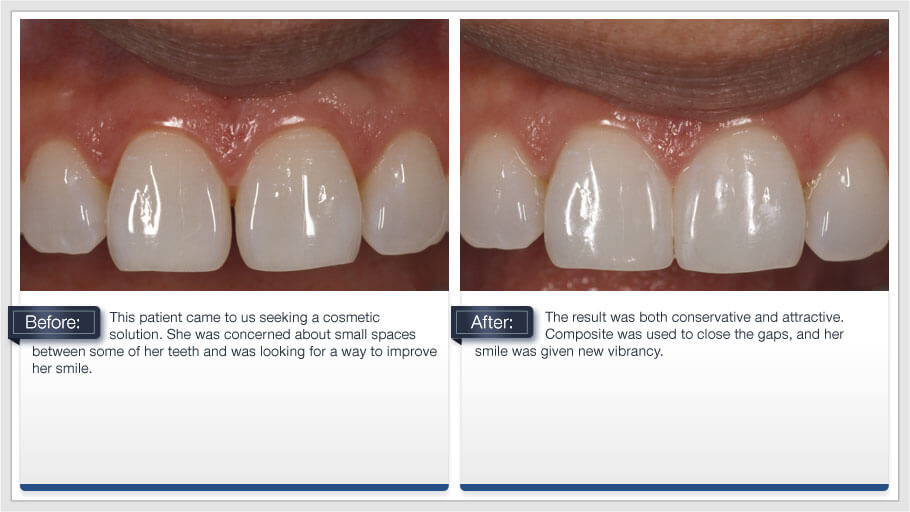

Composite Bonding to Close Space between Teeth
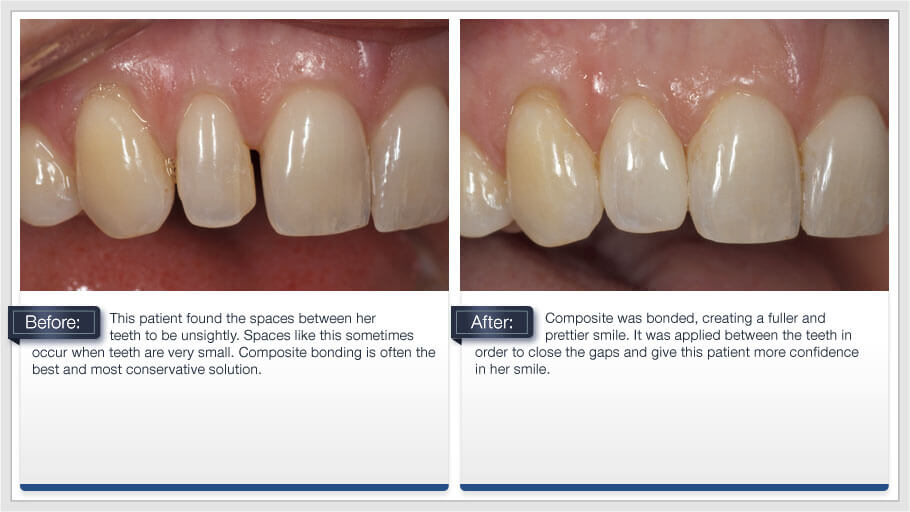

composite bonding for fracture/chipped tooth
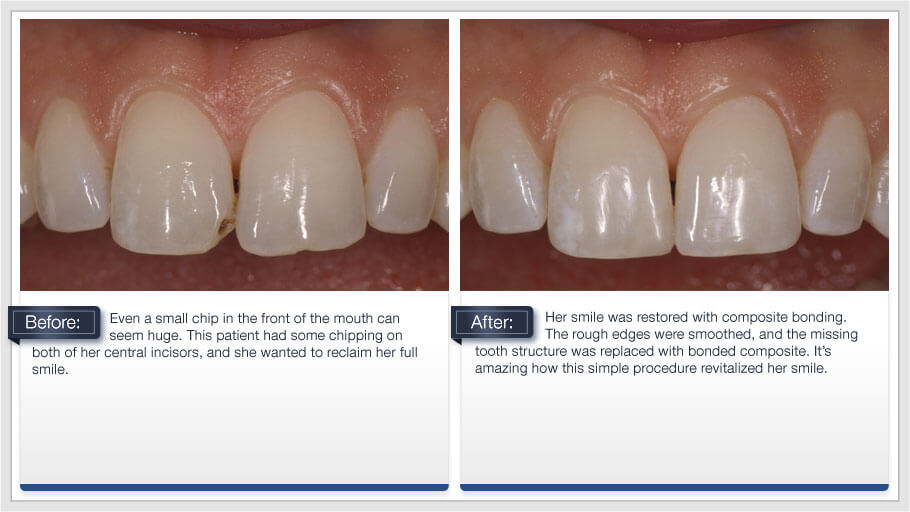

Composite Bonding for Discoloured Tooth


Composite bonding is used to mask discolored tooth, here the tooth-colored composite material is applied to a tooth, sculpted into shape, hardened, and polished.
- Bonding material can become stained. Unlike crowns and porcelain veneers, dental bonding has a tendency to become discolored over time. “Coffee, tea, red wine, and cigarette smoke can stain the material used in dental bonding, making it stand out from the rest of your teeth”. To minimize staining, you’ll need to avoid these substances for 24 to 48 hours after bonding is first performed. If you’re a smoker, you’ll want to choose a different cosmetic dentistry treatment. “Because bonding material is porous, it will yellow from exposure to cigarette smoke.”
- Less durable. Additionally, the material used in dental bonding isn’t as strong and long- lasting as porcelain veneers and crowns. It can easily chip.
Because dental bonding is more susceptible to staining and chipping than other forms of cosmetic dentistry, special care is required to keep your bonded teeth looking natural. Here are some tips to keep your dental bonding in tip-top shape:
- Cut down on coffee, tea, and red wine.
- If you’re a smoker, this is a good reason to quit — not to mention that smoking also increases your risk of gum disease and oral cancer.
- Since dental bonding can chip easily, avoid biting your nails or chewing on hard objects, such as ice, pencils, and raw carrots.
- Call your dentist if you notice sharp edges or if your teeth feel strange when you bite down. If necessary, dental bonding can be repaired or touched up.
Tooth whitening (Bleaching)
Our tooth whitening treatments have been extensively evaluated to provide a safe and proven way to lighten the shade of your teeth allowing you to smile with confidence!
The Tray ¬Based Tooth Whitening Process :
Once your dentist has started your treatment, you will need to continue the whitening as directed by your dentist, at home. This means regularly applying the whitening product over several days for between 60 and 90 minutes per day. By applying a small amount of the gel to the specialised tray and fitting the tray onto your teeth, the home whitening system will remove most stains.
The tooth whitening gel produces oxygen which penetrates the tiny pores in the enamel surface of your teeth. The oxygen removes stains that may have become embedded in the enamel over the years using a safe and easy oxidation process.
We all want to look our best and a brighter, whiter smile can do so much to enhance your appearance and build your confidence.
The Advanced Power tooth whitening treatment :
The tooth whitening gel produces oxygen which penetrates the tiny pores in the enamel surface of your teeth. The oxygen removes stains that may have become embedded in the enamel over the years using a safe and easy oxidation process.
We all want to look our best and a brighter, whiter smile can do so much to enhance your appearance and build your confidence.
Using Advanced Power tooth whitening, The Dental Clinic can whiten your teeth by up to 10 shades in just one treatment, in less than one hour.
The Advanced Power tooth whitening is the latest, most effective in-clinic tooth whitening procedure. It is a bleaching process which lightens discolouration of enamel and dentine. With Advanced Power tooth whitening, patients see results immediately.
Unlike other tooth whitening procedures, Advanced Power tooth whitening can typically provide results six to ten shades lighter following one short visit to the dentist. The convenience of Advanced Power tooth whitening in comparison to tray or strip methods make it the perfect choice for the busy individual.
Your dentist will then apply Advanced Power whitening gel to your teeth. The active ingredient in the Advanced Power whitening gel is hydrogen peroxide. This is applied to the enamel (the protective outer coating) of the tooth and is then heated with a special Advanced Power lamp.
The lamp activates the gel, helping to penetrate the enamel and bleaching away any discolouration without changing the structure of the teeth. When the Zoom! Advanced Power lamp is turned on, the whitening process begins. In less than an hour your treatment is complete
Internal Tooth Whitening:
The Advanced Power tooth whitening is the latest, most effective in-clinic tooth whitening procedure. It is a bleaching process which lightens discolouration of enamel and dentine. With Advanced Power tooth whitening, patients see results immediately.
Unlike other tooth whitening procedures, Advanced Power tooth whitening can typically provide results six to ten shades lighter following one short visit to the dentist. The convenience of Advanced Power tooth whitening in comparison to tray or strip methods make it the perfect choice for the busy individual.
Your dentist will then apply Advanced Power whitening gel to your teeth. The active ingredient in the Advanced Power whitening gel is hydrogen peroxide. This is applied to the enamel (the protective outer coating) of the tooth and is then heated with a special Advanced Power lamp.
The lamp activates the gel, helping to penetrate the enamel and bleaching away any discolouration without changing the structure of the teeth. When the Zoom! Advanced Power lamp is turned on, the whitening process begins. In less than an hour your treatment is complete
This type of tooth whitening technique is used for a discoloured front tooth which has previously had a root canal treatment.
Your dentist will firstly very carefully assess your tooth to make sure that the type of discolouration is suitable for internal tooth whitening.
A small ascess will be created in the back of your tooth and the top of the root canal filling exposed. An impervious lining will be placed over this and then a special whitening gel will be carefully placed into the tooth. A tooth coloured filling material will be used to close the hole.
Normally your dentist will assess your tooth after one or two days. It is common for the gel to require replacement two or three times to achieve the required whitening effect. Once your tooth is whitened, a light tooth coloured permanent filling will be placed in the hole to seal the tooth.
Your dentist will firstly very carefully assess your tooth to make sure that the type of discolouration is suitable for internal tooth whitening.
A small ascess will be created in the back of your tooth and the top of the root canal filling exposed. An impervious lining will be placed over this and then a special whitening gel will be carefully placed into the tooth. A tooth coloured filling material will be used to close the hole.
Normally your dentist will assess your tooth after one or two days. It is common for the gel to require replacement two or three times to achieve the required whitening effect. Once your tooth is whitened, a light tooth coloured permanent filling will be placed in the hole to seal the tooth.
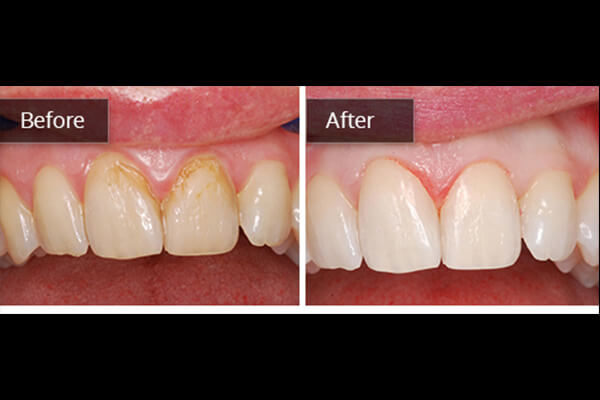
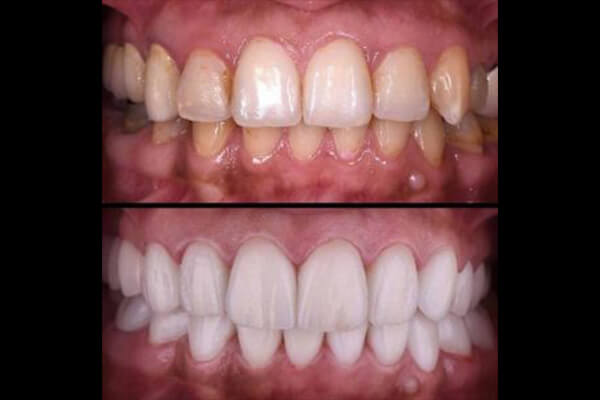
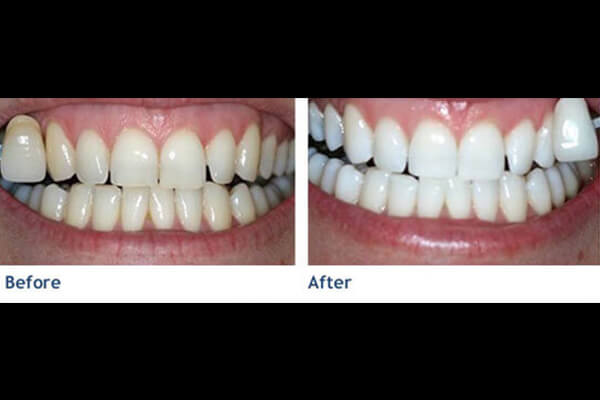
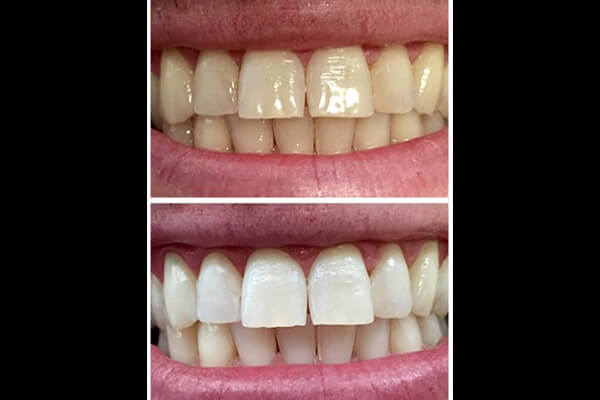
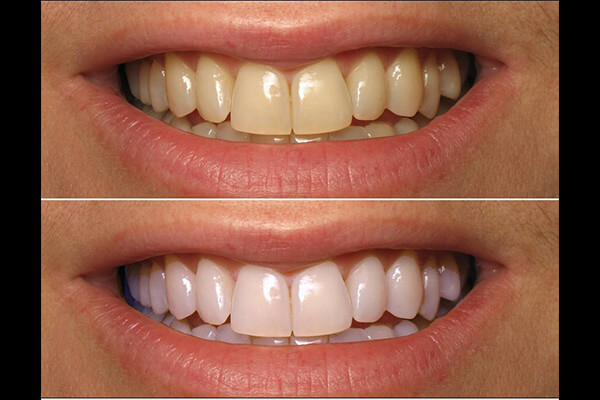
Ceramic Veneers/ Laminates
Dental veneers (sometimes called porcelain veneers or dental porcelain laminates) are wafer-thin, custom-made shells of tooth-colored materials designed to cover the front surface of teeth to improve your appearance. These shells are bonded to the front of the teeth changing their color, shape, size, or length.
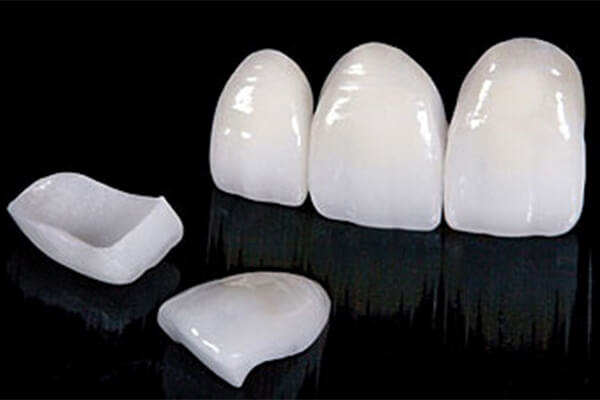
Indications of Ceramic Veneer -
Ceramic Veneer for Discoloured Tooth
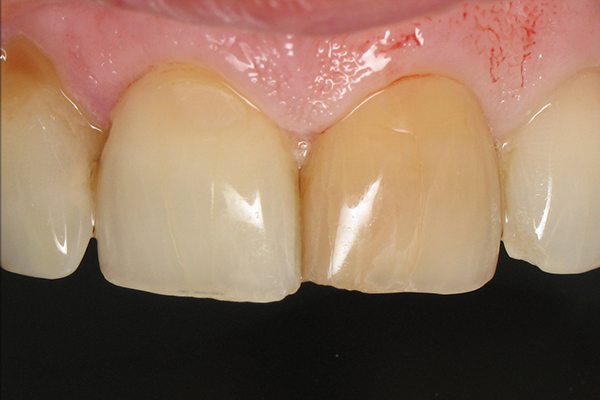
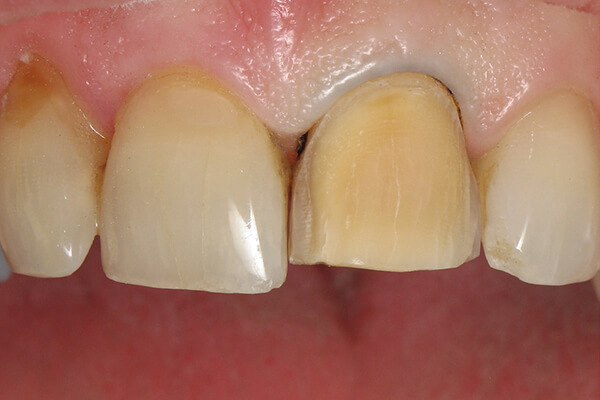
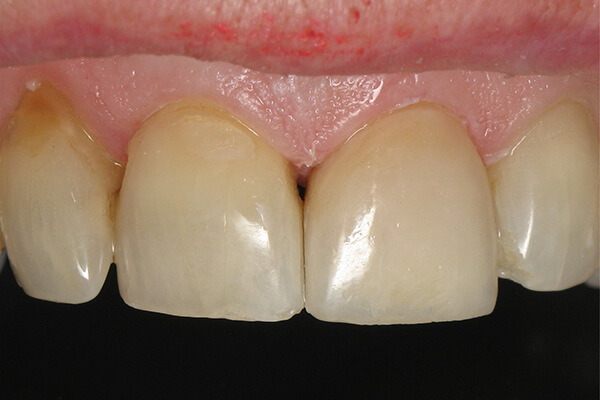 Ceramic Veneer for Irregular Tooth
Ceramic Veneer for Irregular Tooth
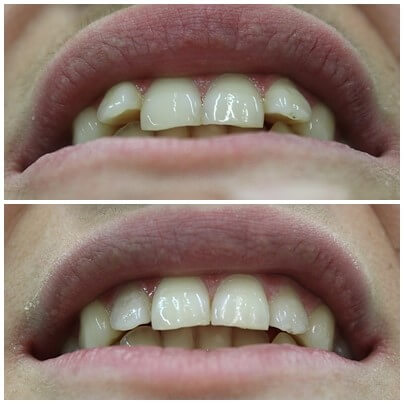 Ceramic Veneer for Spacing
Ceramic Veneer for Spacing
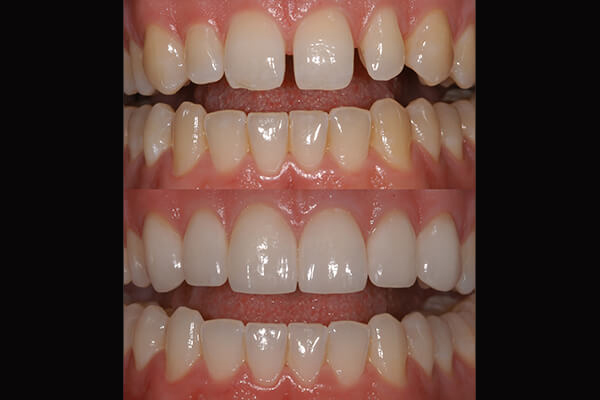 Advantages of Ceramic Veneers –
Advantages of Ceramic Veneers –
- Teeth that are discolored -- either because of root canal treatment; stains from tetracycline or other drugs, excessive fluoride or other causes; or the presence of large resin fillings that have discolored the tooth
- Teeth that are worn down
- Teeth that are chipped or broken
- Teeth that are misaligned, uneven, or irregularly shaped (for example, have craters or bulges in them)
- Teeth with gaps between them (to close the space between these teeth)
Ceramic Veneer for fractured Tooth
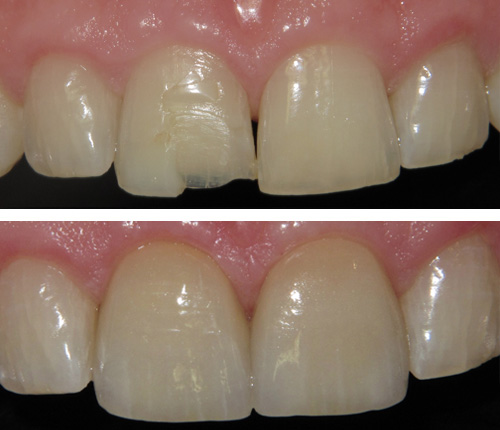






- They provide a natural tooth appearance.
- Gum tissue tolerates porcelain well.
- Porcelain veneers are stain resistant.
- The color of a porcelain veneer can be selected such that it makes dark teeth appear whiter.
- Veneers offer a conservative approach to changing a tooth's color and shape; veneers generally don't require the extensive shaping prior to the procedure that crowns do, yet offer a stronger, more aesthetic alternative.
Developing dental technology has made veneers more lifelike and convenient than ever before. New types of porcelain are stronger and reflect light similarly to natural dental enamel. Digital imaging systems enable many dentists to create same-day restorations that are a near-perfect match to the natural shape and color of patients' teeth.
Gingival contouring
Gingival contouring, also known as gingival sculpting, is the process of reshaping the gum tissue around your teeth.
A cosmetic dental treatment that can help reinvent your smile and improve your oral health, gingival sculpting involves a minimally invasive laser procedure to remove and re-sculpt uneven or excessive gum tissue. Typically, however, soft tissue sculpting also requires bone recontouring that cannot be accomplished with a laser alone. The result is healthy and natural-looking gums for a vital, young-looking and attractive smile that adds to your confidence and appeal.
Sculpting procedures can be performed for cosmetic reasons, as well as for oral health reasons such as poor dental hygiene. The latter can result in the formation of deep gum pockets due to improper tooth brushing and the accumulation of calculus and plaque. Common aesthetic problems that can be corrected include gummy smile (excessive gingival display), uneven (asymmetrical) gingival contours, the loss of papillae (small amounts of gum tissue between your teeth) and exposed root surfaces.
The gum contouring process removes and re-shapes the extra gum tissue to lift the gum line and reveal more teeth and/or even out the gum line for enhanced symmetry.
Gingival sculpting can have psychological and social benefits, improving your looks and self-confidence, encouraging you to be more socially active and making you more willing to smile
A cosmetic dental treatment that can help reinvent your smile and improve your oral health, gingival sculpting involves a minimally invasive laser procedure to remove and re-sculpt uneven or excessive gum tissue. Typically, however, soft tissue sculpting also requires bone recontouring that cannot be accomplished with a laser alone. The result is healthy and natural-looking gums for a vital, young-looking and attractive smile that adds to your confidence and appeal.
Sculpting procedures can be performed for cosmetic reasons, as well as for oral health reasons such as poor dental hygiene. The latter can result in the formation of deep gum pockets due to improper tooth brushing and the accumulation of calculus and plaque. Common aesthetic problems that can be corrected include gummy smile (excessive gingival display), uneven (asymmetrical) gingival contours, the loss of papillae (small amounts of gum tissue between your teeth) and exposed root surfaces.
The gum contouring process removes and re-shapes the extra gum tissue to lift the gum line and reveal more teeth and/or even out the gum line for enhanced symmetry.
Gingival sculpting can have psychological and social benefits, improving your looks and self-confidence, encouraging you to be more socially active and making you more willing to smile
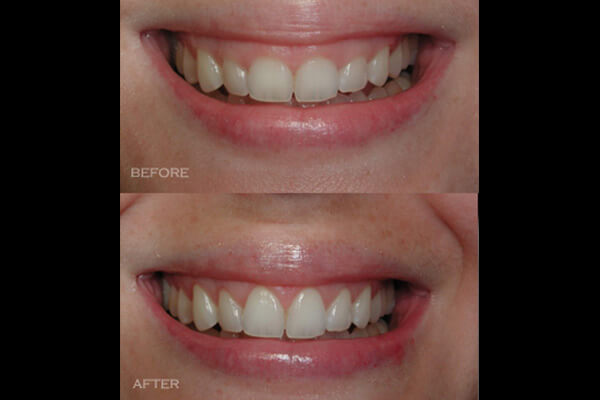
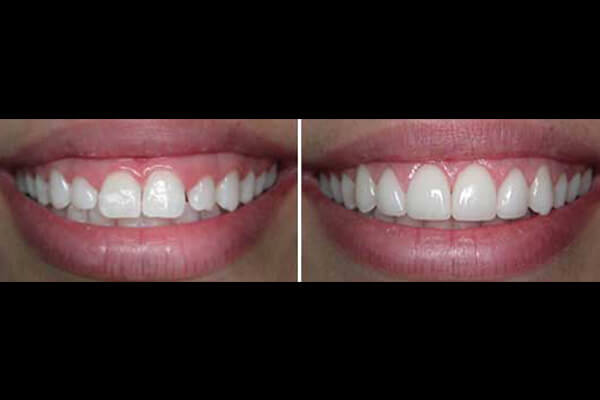
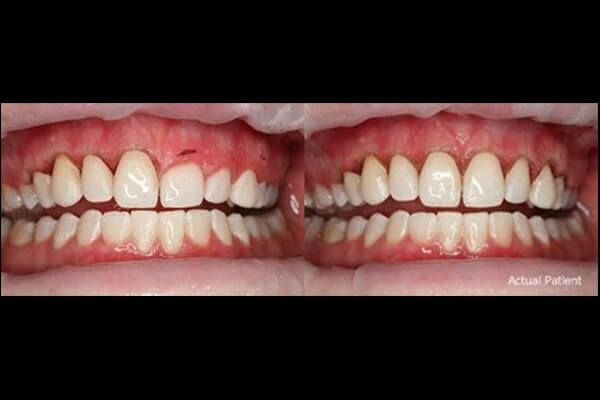
Full Ceramic Crowns
These are a type of cosmetic crown which are made purely from ceramic and no other material. This is in contrast to other types of crowns such as the porcelain fused to metal variety and gold crowns.
The defining feature of these crowns is that they are made from a translucent material which is attractive to look at and blends in well with the rest of your teeth.
This means a top quality crown which will last for many years. The majority of all ceramic crowns are produced using computer technology, e.g. CAD/CAM technology which is based upon 3D design.
Full Ceramic Crown for Discoloured Tooth
The defining feature of these crowns is that they are made from a translucent material which is attractive to look at and blends in well with the rest of your teeth.
This means a top quality crown which will last for many years. The majority of all ceramic crowns are produced using computer technology, e.g. CAD/CAM technology which is based upon 3D design.
Case 1
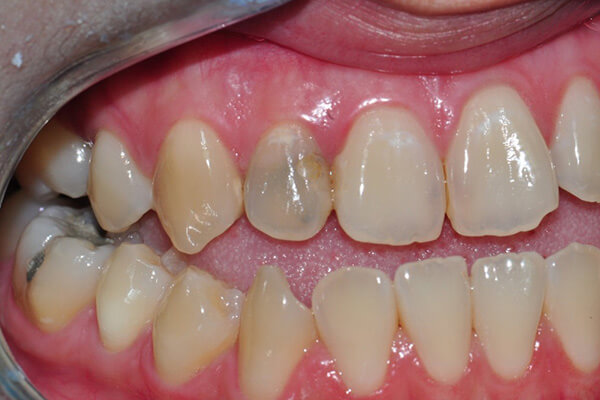
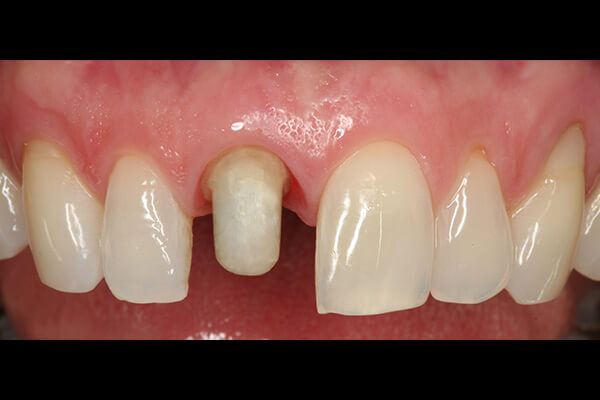
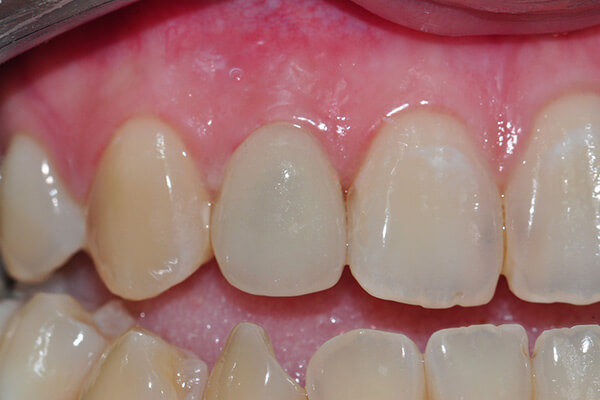 Case 2
Case 2
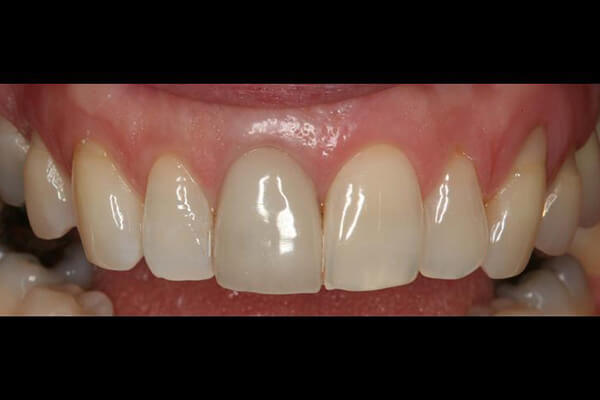
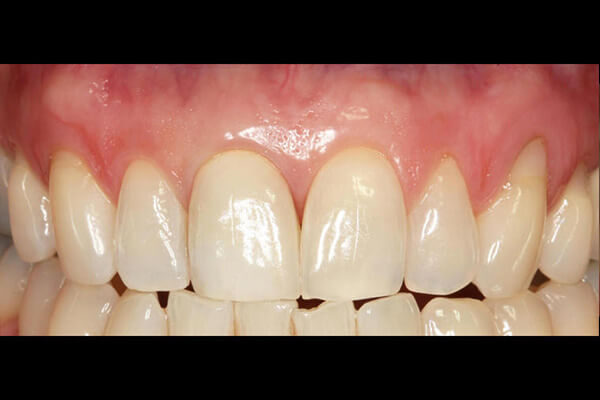





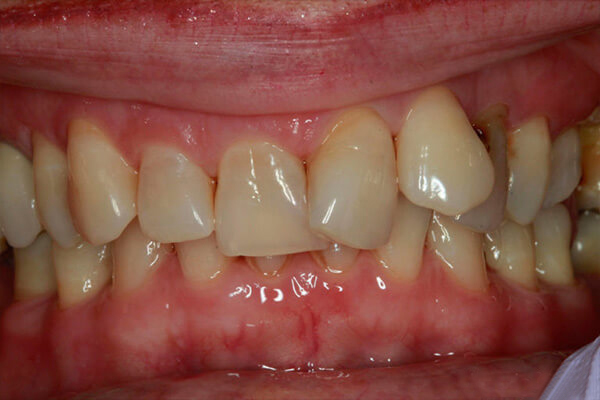
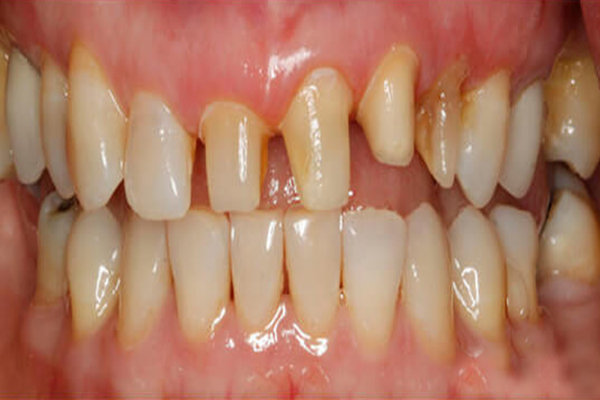
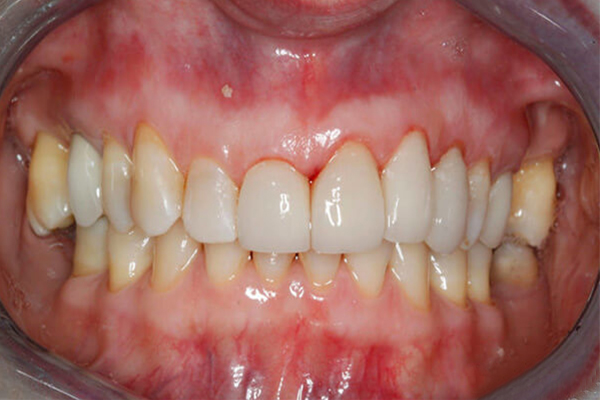
Test Data
Test Data

About
Dr. Prashanth Kumar
Dr. Prashanth Kumar
Dr. Prashanth Kumar's vision to fulfill the need for specialized dental care and treatment resulted in the establishment of Prashanth Dental Clinic in 1999.
He graduated from Government Dental College, Bangalore in 1999. Completed his Diplomat in Orthodontics from ICNOG university, Italy. He is also a fellow in Implant and Esthetic Dentistry. He is an active Member of the International Orthodontic Association and Indian Dental Association. He is also an authorized dental surgeon to KPCL and BHEL.
He graduated from Government Dental College, Bangalore in 1999. Completed his Diplomat in Orthodontics from ICNOG university, Italy. He is also a fellow in Implant and Esthetic Dentistry. He is an active Member of the International Orthodontic Association and Indian Dental Association. He is also an authorized dental surgeon to KPCL and BHEL.
About
Dr. Soujanya Prashanth
Dr. Soujanya Prashanth
Dr. SOUJANYA PRASHANTH graduated from SDM, Dharwad in 2002. She is an active Member of the Indian Dental Association. She is a consultant dental surgeon to BGS GLOBAL HOSPITAL, Kengeri, Bangalore. She is also an authorized dental surgeon to BEL and BHEL.
She started her practice from the year 2004 and with that came the establishment of Procare Dental Clinic , she has evolved the clinic from the basic requirement to advanced facilities to each and every patient.
She started her practice from the year 2004 and with that came the establishment of Procare Dental Clinic , she has evolved the clinic from the basic requirement to advanced facilities to each and every patient.

Need a Doctor for Check - up ?
Just Make An Appointment
Just Make An Appointment
Get in touch
Prashanth Dental Clinic

#175, 15th Main, M.C. Layout,
Opposite Vijayanagar Metro
Station ( Gate A)
Vijayanagar, Bangalore-560040
Opposite Vijayanagar Metro
Station ( Gate A)
Vijayanagar, Bangalore-560040
Procare Dental Clinic

#3, Jnanabharathi Main Road, Nagarabhavi,
Bangalore-560072
Bangalore-560072
Copyright © All Rights reserved | Privacy Policy



